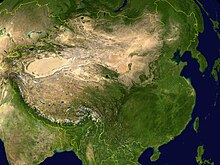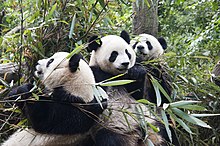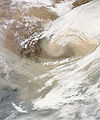Environment of China

The
Geology
The
Biota
Wildlife


Many species of animals are endemic to China, including the country's most famous wildlife species, the giant panda. In all, about one-sixth of mammal species and two-thirds of amphibian species in China are endemic to the country.[8][11]
Wildlife in China share habitat with and bear acute pressure from the world's largest population of
Flora


Climate
Owing to tremendous differences in latitude, longitude, and altitude, the
The northern extremities of both
Annual sunshine duration ranges from less than 1,100 hours in parts of Sichuan and Chongqing to over 3,400 hours in northwestern Qinghai. Seasonal patterns in sunshine vary considerably by region, but overall, the north and the Tibetan Plateau are sunnier than the south of the country.
-
Snow encircling the area around the Bo Hai
-
The first day of spring 2010 brought a massive sandstorm blowing from Inner Mongolia
-
On November 11, 2010, a wall of sand blew across northern China, covering much of the North China Plain and Shandong Peninsula.
-
Smog from Eastern China spread over neighboring areas in February 2004.
-
Natural color satellite image of a smog event in the heart of northern China
-
Dense smog settled over the North China Plain on February 20, 2011.
Climate change

Protected areas of China
This is a list of the nationally designated
Environmental issues
Rapid industrialization, population growth, and lax environmental oversight have caused many environmental issues, such as large-scale pollution in China.[29] As of 2013, Beijing, which lies in a topographic bowl, has significant industry, and heats with coal, is subject to air inversions resulting in extremely high levels of pollution in winter months.[30]
In January 2013, fine airborne particulates that pose the largest health risks, rose as high as 993 micrograms per cubic meter in Beijing, compared with World Health Organization guidelines of no more than 25. The World Bank estimates that 16 of the world's most-polluted cities are located in China.[31]
According to Jared Diamond, the six main categories of environmental problems of China are: air pollution, water problems, soil problems, habitat destruction, biodiversity loss and mega projects.[32] Diamond also states that, "China is noted for the frequency, number, extent, and damage of its natural disasters".[32]
Many of the Chinese citizens started to wonder if air pollution is the cause of the increase of lung cancer. This question began to rise because the citizens in China must constantly wear face masks to avoid breathing in the hazardous particles from their polluted skies. Some experts agree that it is the reason, but others say there isn't enough evidence. Wang Ning, deputy director of the Beijing Office for Prevention and Control, says he has seen a rise in a certain cancer called adenicarcinoma, which is a mucus that is seen as a side effect from pollution. China's lung cancer rate is 32% of the entire world's lung cancer patients. Meanwhile, as lung cancer increases, gastric, esophageal, and cervical cancer have all decreased in China.[33]
See also
- Environmental policy in China
- Environmentalism in China
- Geographic Information Systems in China
- Hot summer cold winter zone
- Land use in China
References
- ^ Edward Wong (21 March 2013). "As Pollution Worsens in China, Solutions Succumb to Infighting". The New York Times. Retrieved 22 March 2013.
- ^ "Asia - Geologic history". Encyclopedia Britannica. Retrieved 8 April 2019.
- ^ "Land and Mineral Resources". www.china.org.cn. Retrieved 11 April 2019.
- .
- JSTOR 24136865.
- ^ "Biodiversity Theme Report". Environment.gov.au. 2009. Archived from the original on 8 December 2008. Retrieved 27 April 2010.
- ^ "China: vertebrate species by type 2015 - Statistic". Statista.com. Retrieved 6 January 2018.
- ^ a b IUCN Initiatives – Mammals – Analysis of Data – Geographic Patterns 2012. IUCN. Retrieved 24 April 2013. Data does not include species in Taiwan.
- ^ Countries with the most bird species. Mongabay.com. 2004 data. Retrieved 24 April 2013.
- ^ Countries with the most reptile species. Mongabay.com. 2004 data. Retrieved 24 April 2013.
- ^ a b IUCN Initiatives – Amphibians – Analysis of Data – Geographic Patterns 2012. IUCN. Retrieved 24 April 2013. Data does not include species in Taiwan.
- ^ Top 20 countries with most endangered species IUCN Red List. 5 March 2010. Retrieved 24 April 2013.
- ^ "Nature Reserves". China.org.cn. Retrieved 2 December 2013.
- ^ Wu, Z. Y., P. H. Raven & D. Y. Hong, eds. 2006. Flora of China. Vol. 22 (Poaceae). Science Press, Beijing, and Missouri Botanical Garden Press, St. Louis
- ^ Fang, R., et al. (2018). Country focus: China. In: K. J. Willis (ed.), State of the World's Fungi. Report. Royal Botanic Gardens, Kew. pp. 48–55
- ^ Hu, R (1990). Distribution of Bryophytes in China (PDF).
- ^ Huang J, Ma K, Huang J (2017). Species Diversity Distribution Patterns of Chinese Endemic Seed Plants Based on Geographical Regions. PLoS ONE 12(1): e0170276 https://doi.org/10.1371/journal.pone.0170276
- ^ Hong, D. Y., & Blackmore, S. (Eds.). (2015). Plants of China: A companion to the flora of China. Cambridge University Press
- ^ World Bank. "China Country Climate and Development Report" (PDF).
- ^ "China National communication 3: Part III Impacts of Climate Change and Adaptation". unfccc.int. Archived from the original on 14 November 2019. Retrieved 26 September 2019.
- ^ "DataBank - CO2 emissions (metric tons per capita)". The World Bank. Archived from the original on 3 October 2020. Retrieved 10 August 2020.
- from the original on 24 July 2021. Retrieved 24 July 2021.
high-income resource-poor nations such as the United Kingdom, Germany and France (...) outsource carbon-intensive production to China
- from the original on 25 July 2021. Retrieved 24 July 2021.
- ^ "Who has contributed most to global CO2 emissions?". Our World in Data. Archived from the original on 25 October 2021. Retrieved 28 October 2021.
- ^ "The hard truths of climate change — by the numbers". www.nature.com. Archived from the original on 26 August 2022. Retrieved 28 October 2021.
- ^ Regan, Helen (5 January 2024). "2023 was China's hottest year on record, marked by multiple deadly extreme weather events". CNN. Retrieved 7 January 2024.
- ^ "Climate change: China aims for 'carbon neutrality by 2060'". BBC News. 22 September 2020. Archived from the original on 26 January 2021. Retrieved 22 September 2020.
- ^ Lui, Swithin (19 May 2022). "Guest post: Why China is set to significantly overachieve its 2030 climate goals". Carbon Brief. Archived from the original on 23 May 2022. Retrieved 24 May 2022.
- ^ Edward Wong (29 March 2013). "Cost of Environmental Damage in China Growing Rapidly Amid Industrialization". The New York Times. Retrieved 30 March 2013.
- ^ "2 Major Air Pollutants Increase in Beijing". The New York Times. 3 April 2013. Retrieved 4 April 2013.
- ^ Bloomberg News (14 January 2013). "Beijing Orders Official Cars Off Roads to Curb Pollution". Bloomberg. Retrieved 27 July 2013.
- ^ ISBN 9780241958681). See chapter 12 entitled "China, Lurching Giant" (pages 258-377).
- ^ Burkitt, Laurie (10 March 2014). "Pollution: Causing Lung Cancer in China?". WSJ. Retrieved 5 May 2017.
Further reading
- Elvin, Mark. The retreat of the elephants: an environmental history of China (Yale University Press, 2004). excerpt
- Heijdra, Martin. "Texts, Space and Time: New Insights into Chinese Environmental History." Journal of the Economic and Social History of the Orient 42.4 (1999): 549-565.
- Maohong, Bao. "Environmental history in China." Environment and History (2004): 475-499. online
- Marks, Robert B. China: An environmental history (Rowman & Littlefield, 2017). excerpt













